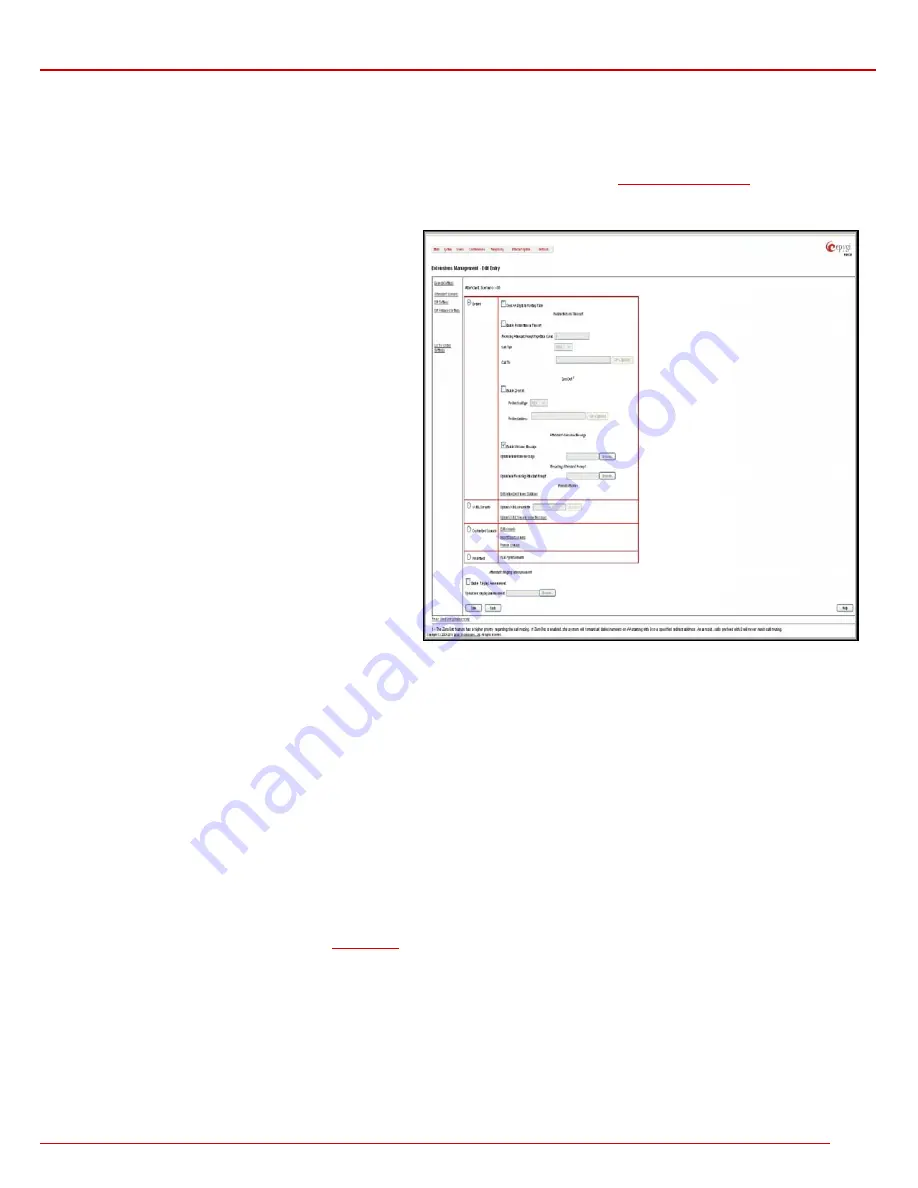
QuadroM 32x/8L/26x/12Li/26xi Manual II: Administrator's Guide
Administrator’s Menus
QuadroM 32x/8L/26x/12Li/26xi; (SW Version 5.2.x)
61
The
Percentage of System Memory
drop down list is used to define the space for the Auto Attendant’s system messages. The maximum value in
the drop down list is equal to the maximum available space for voice messages on Quadro.
2.
Attendant Scenario
This group is used to select between default and custom attendant functionality scenarios. When the
Default
scenario is selected, a group of settings
should be adjusted. Here, the user defined Auto Attendant system messages can be uploaded and the list of
Friendly Phones
can be configured.
For
Custom
scenario, a scenario script file (in EpygiXML coding, the coding standard can be found at
Epygi Technical Support
) should be defined
and the custom voice messages can be uploaded.
The
Default
manipulation radio button selection enables the following components:
•
The
Send AA Digits to Routing Table
checkbox
selection switches the Auto Attendant to the routing
mode. Any inserted digits on the Auto Attendant
prompt will be parsed through the Routing Table on
the Quadro.
•
Redirection on Timeout -
this group allows
automatic call redirection in case no action has been
performed by the caller.
The group offers the following
options:
Enable Redirection on Timeout
checkbox is used to
enable/disable the automatic call redirection.
Recurring Attendant Prompt Repetition Count
text
field indicates the number of Recurring Attendant
Prompts to be consecutively played to the caller with
no action from his/her side. When the Recurring
Attendant Prompt is played the number of times
indicated in this text field, the call will be automatically
redirected to the defined destination.
Call Type
drop down list includes possible incoming
call types (PBX, PSTN, SIP or Auto).
PBX
selection
means that the call will be redirected to the local
extension.
SIP
selection means that the call will be
redirected to the SIP destination correspondingly.
PSTN
selection means that the call will be redirected
to the PSTN destination.
Auto
selection is used for
undefined call types: destination (independent on
whether it is a PBX number, SIP address or PSTN
number) will be reached through Routing.
Fig. II-110: Extensions Management - Edit Entry – Attendant Scenario page
Call To
text field requires the destination number dialed in the format depending on the selected Call Type. The wildcard is supported in
this field.
•
ZeroOut
– this group is used to configure call redirection service on the Auto Attendant. When a caller reaches the Auto Attendant, he may
want to accelerate the automatic redirection feature instead of using Auto Attendant features. To activate ZeroOut, caller should dial
digit (see Feature Codes) during the Auto Attendant welcome message. The caller will then be automatically transferred to the destination
specified in this page.
Enable ZeroOut
checkbox selection enables the ZeroOut feature and activates the following fields to be inserted:
Redirect Call Type
drop down list includes the available call types:
o
PBX - local calls between Quadro extensions and the Auto Attendant
o
SIP – calls through a SIP server
o
PSTN – calls to PSTN
o
Auto – used for undefined call types. Destination (independent on whether it is a PBX number, SIP address or PSTN number)
will be reached through Routing.
The
Redirect Address
text field requires the destination address where the caller should be automatically forwarded to if activating the
ZeroOut feature.
Attention:
The routing patterns in the
Call Routing
table starting with digit “0” will not work for incoming calls to attendant if both the
ZeroOut and
Send AA Digits to Routing Table
options are enabled. The ZeroOut feature has a higher priority. If it is enabled and used,
the system will forward all incoming calls to attendant to the specified redirect address. As a result, calls prefixed with 0 will never reach
call routing.
•
Attendant Welcome Message
- this group allows updating the active Auto Attendant welcome message (played only once when entering
Auto Attendant), downloading it to the PC, or restoring the default one. The group offers the following components:
Enable Welcome Message
checkbox is used to enable/disable the Auto Attendant welcome message (the default one or the custom one
uploaded from this page or recorded from the handset (see Feature Codes) being played when callers enter Quadro’s Auto Attendant.
Upload new welcome message
indicates the file name used to upload a new welcome message. The uploaded file needs to be in PCMU
(CCITT u-law, 8 kHz, 8 bit Mono) wave format, otherwise the system will prevent uploading it and the “Invalid audio file, or format is not






























